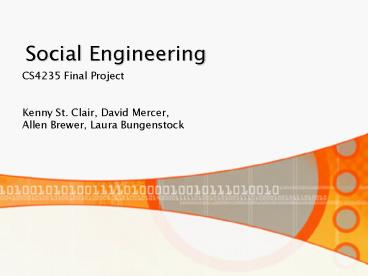Social Engineering - PowerPoint PPT Presentation
1 / 34
Title: Social Engineering
1
Social Engineering
- CS4235 Final Project
- Kenny St. Clair, David Mercer,
- Allen Brewer, Laura Bungenstock
2
Outline
- What is it?
- How is it done?
- Who is at risk?
- CoC Security Audit
3
What is it?
- Social engineering is the oldest form of hacking.
- Social engineers focus on the users of the
system. By gaining the trust of the user, a
social engineer can simply ask for whatever
information he or she wantsand usually get it.
4
The Weakest Link
- As software and hardware becomes increasingly
secure, the weakest element continues to persist. - The people that use the network are the weakest
link!
5
A social engineers mantra
- There is no patch for human stupidity.
6
Definitions
- Social engineering is a use of psychological
knowledge to trick a target into trusting the
engineer, and ultimately revealing information - -Ross Bearman
- involving the use of social skills and personal
interaction to get someone to reveal
security-relevant information and perhaps even to
do something that permits an attack - -Charles and Shari Pfleeger
7
Definitions
- A hackers clever manipulation of the natural
human tendency to trust. The hackers goal is to
obtain information that will allow him to gain
unauthorized access to a valued system and the
information that resides on that system - -Sarah Granger
- uses deception, influence, and persuasion
against businesses, usually targeting
information - -Kevin Mitnick
8
Our Definition
- Social engineering is a psycho-social attack that
subverts human trust and helpfulness in order to
attain the attackers goals.
9
Outline
- What is it?
- How is it done?
- Who is at risk?
- CoC Security Audit
10
How is it done?
- Attacks come in various forms
- On the phone, over e-mail, in person
impersonation
11
Impersonation
- Play the part!
- Social Engineers must
- Anticipate problems
- Know jargon and procedures of the role
12
Impersonation
- And most importantly, knowledge of how to build
trust with whomever they need information from. - Social engineers most often impersonate authority
figures, assistants to authority figure, and new
employees.
13
More techniques
- Dummy Mode
- Bury the key question
- Research (Google)
14
Over the phone
- The phone is the most popular method of social
engineering because it is difficult to verify or
deny someones identity.
15
Over e-mail and IM
- E-mail attacks are very common (phishing).
- E-mail is also used for impersonation.
- Obtaining password for an IM account could lead
to access to a bank account, other personal data.
16
Dumpster diving
- Digging through trash at corporations in search
of sensitive data.
17
Outline
- What is it?
- How is it done?
- Who is at risk?
- CoC Security Audit
18
Who is at risk?
- Everyone.
- Everyone with information is a potential target!
19
Real World Examples
- 90 of office workers gave away their password
for a pen. - 70 of people who trade their password for a bar
of chocolate.
20
Real World Examples
- 1/3 of the IRS employees provided their user name
and changed their password in a 2005 security
audit. - USC vs. Cal basketball game
21
Outline
- What is it?
- How is it done?
- Who is at risk?
- CoC Security Audit
22
CoC Security Audit
- Hands-on experience
- Test the weakest link
- Cleared to target CoC faculty, staff, and
students
23
CoC Security Audit
- GOAL Collect as much data as possible that was
either sensitive or gave access to sensitive
data.
24
CoC Security Audit
- Our plan for collecting data
- E-mail impersonation
- Phone impersonation
- Dumpster diving
25
E-mail Impersonation
- Abuse the Georgia Tech alias system
- tso-security_at_gatech.edu
- Eniola.Okeowo_at_gatech.edu
26
E-mail Impersonation
- By using the tso-security alias we could target
faculty, using Keith Watsons name as the
signature. - By using eniola.okeowo we could target our fellow
students.
27
E-mail Impersonation
- 12 hours later, OIT had revoked our aliases,
according to - Section of Policy Violation 2.3.1. User
Impersonation/False Identity.
28
Plan B
- Change the outgoing address on our e-mail to
Eniola Okeowo, and use the advantage of the
random gtg e-mails as the reply-to. - In total we received 11 replies with GTID
information. - 2 replies were sent directly to Eniola.
29
Dumpster Diving
- Professors often put their trashcans outside
their offices before leaving for the day to allow
janitors to take away their trash. - The CoC is rarely (if ever) empty, and searching
these bins before the janitors arrive is
difficult.
30
Dumpster Diving
- No sensitive data was found.
- The trash removal policy at the CoC made it
difficult for us to effectively dumpster dive.
31
Phone impersonations
- Of the professors we reached over the phone, none
released their passwords to us. - Common responses were
- I do not give passwords out over the phone.
click - Let me check on this and get back to you.
32
Audit Conclusions
- Faculty and staff of the CoC are clearly trained
how to handle and protect sensitive information. - Althoughwe are concerned with the students
understanding of the semi-sensitive nature of the
GTID, especially if combined with data
aggregation.
33
Outline
- What is it?
- How is it done?
- Who is at risk?
- CoC Security Audit
34
Questions?
- Any questions?

